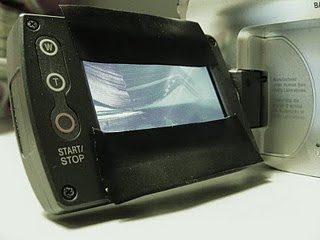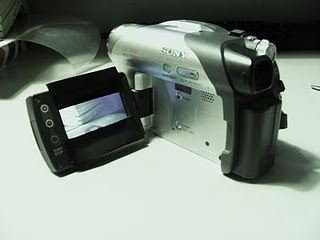The first modification to the raw footage is to perform an anamorphic crop, i.e to change the aspect ratio from the standard 4:3 (as most video cameras, including the one we used, film in) into a widescreen (16:9) format. This would make the images on screen narrower in terms of height, but much wider in terms of width of image. It creates a narrower, almost letterbox-style image, cropping the top and bottom, and though it doesn't sound like much of a modification, it does make a huge difference to the viewing of the video, and beyond anything else, makes it look far more cinematic in its appearance.
Below is a trick Mike did to ensure that, when shooting, he took into account the adding in of the anamorphic crop - simply taking two strips of duct tape and attaching them to the top and bottom of the flip-out screen on the camera.

 This meant that, when filming, he could ensure that all the shots were how they would be when the anamorphic crop will be applied. It is a simple but very effective trick.
This meant that, when filming, he could ensure that all the shots were how they would be when the anamorphic crop will be applied. It is a simple but very effective trick.The second effect involves modifying the composite mode of the footage. By overlaying one clip on top of the other (with both clips being exactly the same), modifying the composite mode to the Overlay setting, and then playing around with the colour correction tool, it can be used to bring out certain colours and make the overall video lighter or darker (in our case, lighter) by modifying the colour balance, hue and saturation.
Below is a video demonstrating exactly how to apply this technique in Final Cut, the software we are using to edit down our footage into the video.
This is a screen-grab of the colour correction frame, on the settings that we intend to use for our video. As you can see, the hue and saturation can be modified, as well as the levels for the blacks, mids and whites.

Below is a short preview video, using a shot from our raw footage, showing first the normal footage as it came off the tape, then the same footage with the anamorphic crop in place, then the same piece of footage again with the crop and the composite mode modified to the softer light setting.
More to follow...

No comments:
Post a Comment